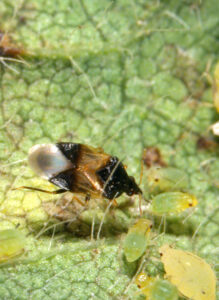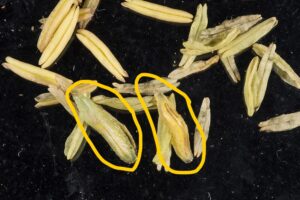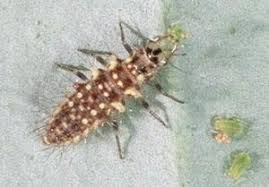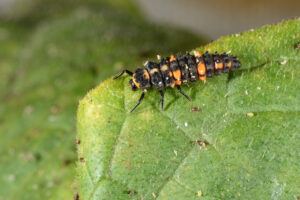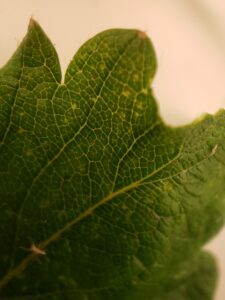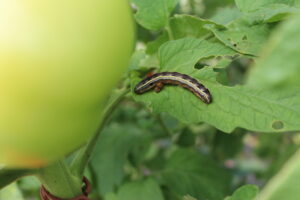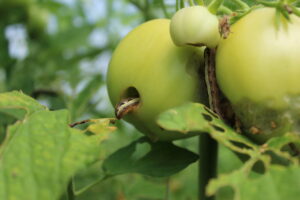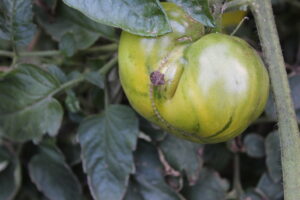If you’re like us, as the season winds down it may seem like your insect pest management efforts are beginning to look a bit more reactive and less preventative. We’re hearing from growers that aphids, mites, caterpillars and stinkbugs are especially challenging in various veggie crops now, particularly tomatoes! In an attempt to ease some stress, here’s a few tips about identifying the signs and symptoms of damage by these late-season pests, focusing on tomatoes.
Aphids
Remember that most aphids prefer to feed on the underside of leaves and on developing leaf tissue. Look for the aphids themselves, their shed exoskeletons (exuvia), or a shiny leaf surface where excess honeydew (aphid excrement) has been deposited. Aphids can be winged, or wingless. The main concern with aphid infestations is the transmission of plant pathogens and the cumulative loss of nutrients as they literally suck the fuel right out of the crop. However, you need not worry about pathogen transmission if infestations occur near harvest. If growing under cover (greenhouse, high tunnel, etc.), aphid populations can grow quickly and result in reduced fruit quality. The common aphid culprits on tomato are the green peach aphid and tomato/potato aphid. The former has a broad host range and can move from weed to crop to weed. The latter only feed on solanum crops and weeds (nightshades, tomato, pepper, potato and eggplant). If you have not been spraying a lot of insecticides throughout the season, you will likely find a variety of aphid natural enemies. Before making any applications to control aphids, take an inventory of the natural enemies that are present and evaluate their impact on the population. This can include flagging an infested plant, coming back 2-3 days later to see if that population has grown and spread, or if it has remained the same. Natural enemies include the minute pirate bug (Figure 1), syrphid fly larvae (Figure 2), parasitoid wasps, lacewing larvae (Figure 3), and lady beetle adults and larvae (Figure 4). If a pesticide application is needed, using a product such as Beleaf® can target piercing-sucking pests, such as aphids, with minimal negative effects on beneficial natural enemies.
Mites
This time of year two spotted spider mites can be one of the most threatening pests. They will feed on leaves and move onto the fruits themselves. They are very small and difficult to detect until the populations are at high levels, producing the visible webbing they use as a highway to move among the plants. For early identification, look for stippling on the upper surface of leaves (Figure 5). This symptom is the result of their feeding on and damage to individual cells of the leaf. In hot and dry conditions, especially if the plants are drought stressed, two spotted spider mite populations can grow rapidly. Again, flag any parts of the plant where you see the mites and watch for an increase in their damage on individual leaves or more symptoms on surrounding leaves. There are a number of mite natural enemies (including other predatory mites) that may be present and suppressing the spider mite population. If you see that damage is worsening and have many weeks of production left, or young susceptible plants next to the infested crop, make an application of a miticide. Spider mites have a wide host range and can feed on multiple crop and weed plants. If there are only 1-2 weeks left in your production, then a treatment is likely not necessary.
Caterpillars
There are several kinds of caterpillars that may feed on tomato leaves and fruits, including tomato hornworm, armyworms, and earworms/fruitworms. These caterpillars can be devastating, especially in high tunnels – they may eat lots of foliage from plants, reducing plant vigor, bore directly into ripe or unripe fruit, and several species produce large amounts of frass (insect poo) that accumulates in fruit wounds and is just plain unsightly (Figures 6a,b). If you have caterpillars in your tomato crop, you are likely to identify their symptoms easily: look for large, open holes in leaves and open wounds (sometimes with the culprit present!) in fruits. Signs of caterpillars may be a bit trickier as some caterpillars are experts at camouflage and may hide in plain sign. However, because they usually eat a lot, they produce a lot of waste (a key sign!), so you can follow their trail of frass to where they are on the plant. Be sure to get a confirmation on the ID of caterpillars in your crop and follow the appropriate scouting and action thresholds before applying an insecticide. As with other pest insects, caterpillars have a suite of natural enemies that attack them, particularly parasitoid wasps and predatory stink bugs, and by limiting excessive sprays against caterpillars, you can reduce flare-ups of secondary pests, like mites and aphids. If applications are warranted, there are many Bacillus thuringiensis (Bt) products (such as DiPel® or Agree®) that are effective against most of these species and target only lepidopterans (butterflies and moths).
Stinkbugs
Stinkbugs are piercing-sucking feeders that cause cosmetic damage and reductions in tomato fruit quality, particularly in tomato varieties destined for solid-pack or fresh market. Fruits that have been damaged by stinkbugs are still safe to eat, but they may not look as appealing (Figure 7). You are more likely to see stinkbug damage than the stinkbugs themselves on your tomatoes – although if you search you may certainly find them! The stinkbugs that are most likely to be feeding on your tomato crop are the one-spotted stink bug and the brown marmorated stink bug. Both nymphs and adults of these stinkbugs may feed on green or red fruits, and feeding damage may not be obvious until harvest. Look for needle-pin like spots on the surface of green fruits, but note that a faint, white ring will appear around feeding spots on red (ripe) tomatoes. Stinkbugs also have their natural enemies, including parasitoid wasps, other predatory bugs and stinkbugs, and spiders. Insecticide applications are more likely to be needed in solid-pack or fresh market plantings, and if they are needed growers can use organic products such as kaolin clay or insecticidal soap, or a range of synthetic active ingredients. It is important to get good coverage of and penetration into the plant canopy- if possible apply products with ground equipment because they provide better coverage into the plant canopy and soil beneath plants.
Please consult the Midwest Vegetable Production Guide (mwveguide.org) for spray recommendations and note that we have updated filters in the search so if you are growing under cover you can select only products allowed in a greenhouse, or only organic (OMRI) approved, etc. And as always, the label is the law.
